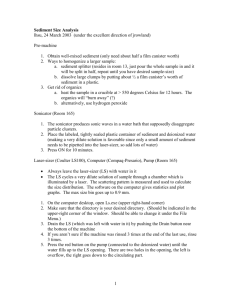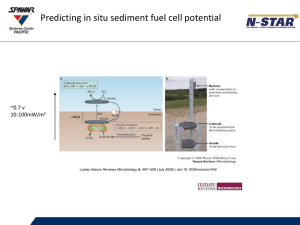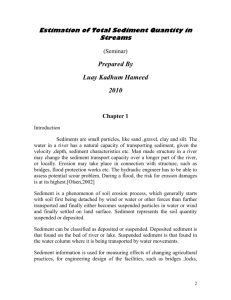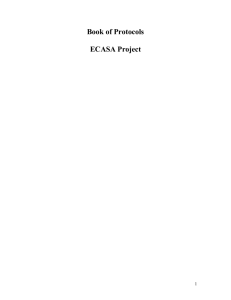Water / Sediment Testing - Lead Abatement Projects
advertisement
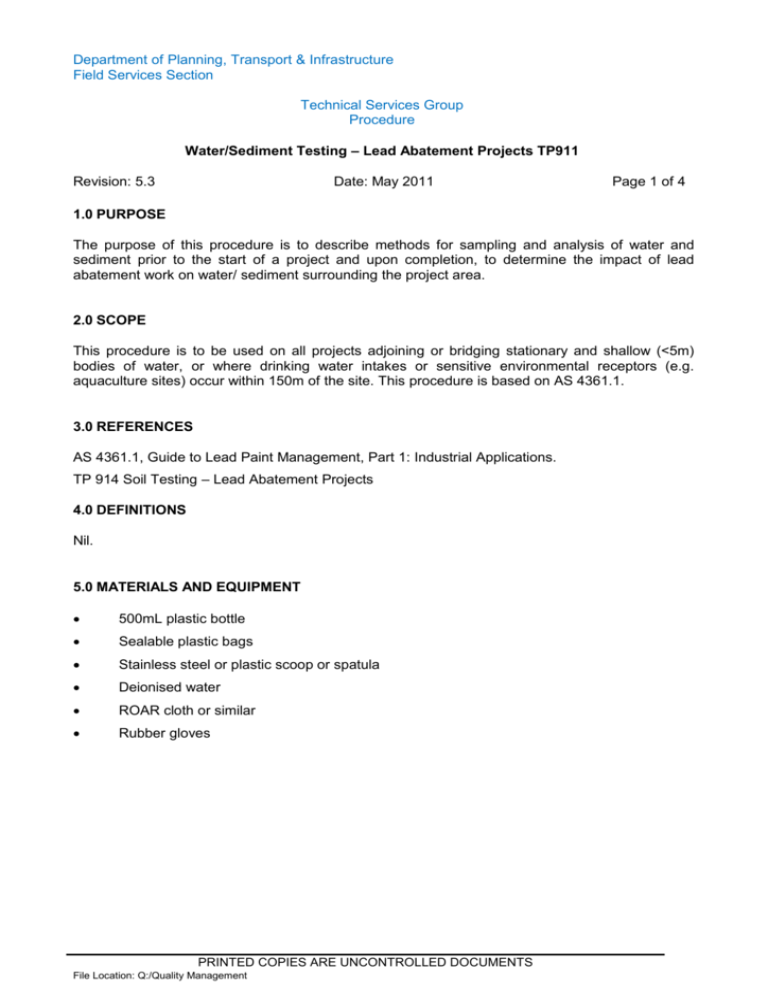
Department of Planning, Transport & Infrastructure Field Services Section Technical Services Group Procedure Water/Sediment Testing – Lead Abatement Projects TP911 Revision: 5.3 Date: May 2011 Page 1 of 4 1.0 PURPOSE The purpose of this procedure is to describe methods for sampling and analysis of water and sediment prior to the start of a project and upon completion, to determine the impact of lead abatement work on water/ sediment surrounding the project area. 2.0 SCOPE This procedure is to be used on all projects adjoining or bridging stationary and shallow (<5m) bodies of water, or where drinking water intakes or sensitive environmental receptors (e.g. aquaculture sites) occur within 150m of the site. This procedure is based on AS 4361.1. 3.0 REFERENCES AS 4361.1, Guide to Lead Paint Management, Part 1: Industrial Applications. TP 914 Soil Testing – Lead Abatement Projects 4.0 DEFINITIONS Nil. 5.0 MATERIALS AND EQUIPMENT 500mL plastic bottle Sealable plastic bags Stainless steel or plastic scoop or spatula Deionised water ROAR cloth or similar Rubber gloves PRINTED COPIES ARE UNCONTROLLED DOCUMENTS File Location: Q:/Quality Management Department of Planning, Transport & Infrastructure Field Services Section Technical Services Group Procedure Water/Sediment Testing – Lead Abatement Projects TP911 Revision: 5.3 Date: May 2011 Page 2 of 4 6.0 PROCEDURE 6.1 Sampling Requirements A sampling plan shall be established, based on the following guidelines. 6.1.1 Structures Adjoining Body of Water For structures located next to a body of water, soil sampling and testing shall be carried out in accordance with TP914. Where soil is not present, samples of water or sediment shall be taken, as follows: One sample of water or one sample of sediment at the shoreline at both ends of the structure. One sample of water or sediment for each 30m of length of the structure and one sample 30m beyond the structure extremities. A minimum of 4 samples of soil or water shall be taken. 6.1.2 Structures Bridging Body of Water The following samples shall be taken: One sample of water and one sample of sediment at the shoreline under either end of the structure. One sample of water and one sample of sediment taken approximately 30m along the shore from bridge abutments. Samples shall be taken both upstream and downstream, and on both banks. For structures 60m in length or longer, one sample of water and one sample of sediment shall be taken commencing at 60m from the bridge abutments, with additional samples at 30m intervals for each 30m of structure length in excess of 60m. Samples shall be taken both upstream and downstream, and on both banks. A minimum of six samples of water and sediment shall be taken. 6.1.3 Sensitive Receptors Where sensitive receptors such as drinking water intakes or aquaculture sites are located within 150m of the work site, collect sufficient samples to fully characterise the site. 6.2 Sampling Frequency Samples shall be taken prior to project start-up and upon completion. Interim sampling may be undertaken to determine effectiveness of containment during the course of the project, or where breaches of containment are suspected or observed. PRINTED COPIES ARE UNCONTROLLED DOCUMENTS File Location: Q:/Quality Management Department of Planning, Transport & Infrastructure Field Services Section Technical Services Group Procedure Water/Sediment Testing – Lead Abatement Projects TP911 Revision: 5.3 6.3 Date: May 2011 Page 3 of 4 Sampling Procedure 6.3.1 Water Sampling 1) Thoroughly rinse bottles and caps in the water to be sampled. 2) Sample water by dipping the bottle into the water, ensuring that all air has been displaced from the bottle. Seal bottle. Note: Gloves must be worn at all times to prevent contamination of the sample. 3) Label the bottle using a permanent marker, including the following: project name sample location sample identifier date time name of sampler 4) Record all details on the worksheet, then register each sample in accordance with the relevant sample receipt procedure, and assign sample numbers. These numbers must be used at all times to ensure the correct matching of analysis results with the sample. Add the sample number to the bottle using a permanent marker. 5) Forward all samples simultaneously to test authority for analysis of lead content. The current limit for lead in fresh and marine environments is 5µg/L (2009). The test laboratory shall be instructed to provide analysis to at least the nearest 0.1µg/L. 6.3.2 Sediment Sampling 1) 2) Label the plastic bag using a permanent marker, including the following: project name sample location sample identifier date time name of sampler Sample the top 100mm of sediment, using the scoop or spatula, and place in the sample bag. Sample approximately 250mL of material. PRINTED COPIES ARE UNCONTROLLED DOCUMENTS File Location: Q:/Quality Management Department of Planning, Transport & Infrastructure Field Services Section Technical Services Group Procedure Water/Sediment Testing – Lead Abatement Projects TP911 Revision: 5.3 Date: May 2011 Page 4 of 4 3) Record all details on the worksheet, then register each sample in accordance with the relevant sample receipt procedure, and assign sample numbers. These numbers must be used at all times to ensure the correct matching of analysis results with the sample. Add the sample number to the plastic bag using a permanent marker. 4) Forward all samples simultaneously to test authority for analysis of lead content. The accuracy required shall be communicated to the test authority to ensure that the resolution of the test is sufficient to demonstrate compliance. 7.0 INTERPRETATION OF RESULTS Water is considered to be contaminated if: 1) Paint chips or debris are visible in the sample. 2) The mean pre-project level was less than 3.5µg/L and an increase of 1.5µg/L is recorded. 3) The mean pre-project level is greater than 3.5µg/L and the 80% confidence level of the post-project mean levels is more than 10% higher than the 80% confidence level of the pre-project mean. Sediment is considered to be contaminated if paint chips or debris are visible in the samples. The acceptance limits for analysis of sediment shall be the subject of agreement prior to commencement of the project, taking particular account of the background levels. 8.0 DOCUMENTATION Test reports shall be retained in the project file. Complete form TP911-1. 8.1 Report Results shall be reported to the Project Manager in the form of a short report. PRINTED COPIES ARE UNCONTROLLED DOCUMENTS File Location: Q:/Quality Management Department of Planning, Transport & Infrastructure 19 Bridge Rd Walkley Heights Ph (08) 8260 0230, GPO Box 1533, Adelaide SA 5001 Technical Services Group Procedure Water/Sediment Testing – Lead Abatement Projects TP911 Pre-project/ Post-project/ Interim* * Strike out that which is not applicable PROJECT DESCRIPTION Structure Name Location Plan No. MONITORING PLAN Comments: …………………………………………………………………………………… …………………………………………………………………………………………………… Plan prepared By: ……………………………………………Title: ……………………… Form TP911-1, Revn. 5.3 PRINTED COPIES ARE UNCONTROLLED DOCUMENTS File Location: Q:/Quality Management




